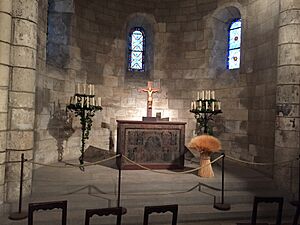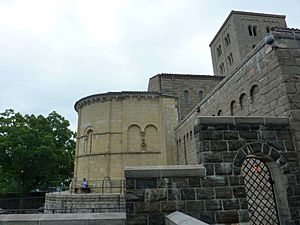The Fuentidueña Apse facts for kids
The Fuentidueña Apse is a very old part of a church, built between 1175 and 1200. It's a special rounded or curved section at the end of a Romanesque church. This apse was originally part of the San Martín Church in a town called Fuentidueña in Spain.
We don't know much about how the church was first designed or built. People think it was important because Fuentidueña was a key town for the Christian kings of Castile. They needed to defend against Moorish invaders. The church was built on a tall hill, right below a strong castle.
By the 1800s, the church was old and falling apart. In the late 1940s, this amazing apse was carefully moved and rebuilt in The Cloisters museum in New York City. Moving it was a huge job! Almost 3,300 stone blocks were shipped all the way from Spain to New York. This move happened after 30 years of talks between the Spanish church, art experts, and governments from both countries. The apse was finally traded in a complex deal. New York gave six beautiful frescoes (wall paintings) from the San Baudelio de Berlanga church to the Prado Museum in Spain for a very long loan.
Today, you can see the apse in the Cloisters' Fuentidueña hall. This is the museum's biggest room.
Contents
What is the Fuentidueña Apse?
The Fuentidueña Apse is a large structure. It measures about 9 meters (30 feet) tall, 7.5 meters (24.5 feet) wide, and 8.4 meters (27.5 feet) deep. It has a wide arch that leads into a rounded ceiling called a barrel vault. This vault then ends in a half dome.
The outside wall of the apse has three small, narrow windows. They were designed to let in as much light as possible. These windows were once part of strong, fortress-like walls. An art historian named Bonnie Young said that these small windows and huge walls make the church feel very serious and simple. This was common for Romanesque churches.
The apse has supporting columns called piers. These piers show three large figures. On the left is Saint Martin of Tours, who was the church's patron saint. On the right, you can see the angel Gabriel. He is shown in the act of the Annunciation, telling the Virgin Mary she will have a baby.
Above the Annunciation scene, a stone carving (called a capital) shows a scene from the Nativity (the birth of Jesus). Below the main arch, two columns have capitals that show more stories. On the left, you can see the Adoration of the Magi. On the right, it shows Daniel in the lions' den. Other carvings on the apse, called blind arcades, have pictures of strange and wonderful creatures. The decorative borders, or moldings, are carved with patterns that look like billets (small blocks) and flowers. The walls also have several "oddly shaped" spaces called niches. These were probably used to hold items for church services.
Moving the Apse to New York
The apse was built from more than 3,300 separate stone blocks. Most of these stones are sandstone and limestone. All these blocks were shipped to New York in 839 different crates!
Putting the apse back together in The Cloisters was a huge and difficult project. It was so big that the museum had to completely change its "Special Exhibition Room" to fit it. The apse opened to the public in 1961, seven years after it arrived. Rebuilding it was a major and new idea for museums at the time. The new space in the museum tries to look like a single long hallway of a church.
Inside the Fuentidueña Apse at The Cloisters, you can see other old artworks. In its dome, there is a large wall painting (fresco) from about 1130–1150. This fresco came from the Spanish Church of Sant Joan de Tredòs. Its colors look a bit like a Byzantine mosaic. It honors the idea of Mary as the mother of God. Also hanging inside the apse is a large crucifix from about 1150–1200. This cross came from the convent of St. Clara in Astudillo, Spain.
Artworks with the Apse
The Fuentidueña Apse has a large, impressive Crucifix hanging in front of it. This cross was made between 1150 and 1200 from white oak, pine, and red paint, with gold details. The cross is about 178 cm (5.8 feet) high and 260 cm (8.5 feet) wide. It is believed to have come from the convent of St. Clara in Astudillo, Spain. However, the records are not completely clear. This cross was likely made to hang above an altar. On the back of the cross, there is a picture of the Agnus Dei ("Lamb of God"). This image is decorated with red and blue leaves around its edges.
How the Apse Came to New York
In the early 1930s, a kind person named John D. Rockefeller Jr. helped pay for The Cloisters museum to get many old architectural pieces from Europe. He sent people to Europe, especially France, to find a church apse that would fit the museum. In 1931, they found the apse from the San Martín Church in Fuentidueña. It had just been named a Spanish National Monument.
However, there was a problem. Both the Catholic Church and the Spanish government said they owned the building and the land. So, no agreement could be made to buy it.
There are no records left from when the apse was first built. It was made in the mid-1100s. At that time, Fuentidueña was very important for the Kingdom of Castile as they fought against the Moors. The church was on a hill, looking grand, and just below a castle. It probably served as the castle's chapel.
The church had been abandoned and was in ruins for a long time. Only the apse was still in fairly good condition. It had no roof, so it had been damaged over hundreds of years. The inside of the apse was even being used as a cemetery. No pictures of its inside existed until 1928. That's when an American art historian, Arthur Kingsley Porter, published two photos of some of its carved figures.
Twelve years later, the Metropolitan Museum (which runs The Cloisters) tried again to get the apse. This time, the Spanish government was more open to the idea. The museum argued that the apse would be better protected in a building with a roof. During the talks, important Spanish figures like Francisco Javier Sánchez Cantón (who later directed the Prado Museum) and Manuel Gómez-Moreno Martínez represented Spain.
The Metropolitan Museum also promised the people of Fuentidueña that they would help their town. They would pay to fix the local San Miguel church and rebuild its tower, which was also falling apart. After many years of talks and discussions with many groups, including the Spanish government, the Bishop of Segovia, and the Fine Arts Academy of San Fernando, an agreement was reached in 1957. The Spanish government agreed to the loan with five main conditions:
- The Metropolitan Museum had to buy six wall paintings (frescoes) from the San Baudelio de Berlanga church. These paintings would then be loaned to the Prado Museum in Spain.
- The museum had to pay for all the drawings and records of the apse. They also had to pay for taking down, packing, and preparing the stones for shipment.
- The museum had to pay for the rebuilding of the San Miguel church in Fuentidueña.
- The museum had to give money to the Fuentidueña town council to help maintain the cemetery and for other town needs.
- The museum had to pay for shipping the apse to New York and rebuilding it there. This included putting a roof over the apse and fixing any damaged stonework. Once rebuilt, a sign had to be put up clearly stating that the apse was on loan from the Spanish government.
See also
 In Spanish: Ábside de Fuentidueña para niños
In Spanish: Ábside de Fuentidueña para niños



